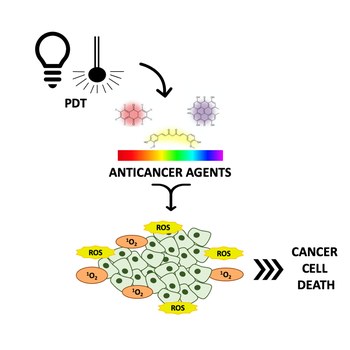
LIGHTNING - LIGHT-ENHANCED CYTOTOXICITY OF ANTICANCER AGENTS BY PHOTOACRTIVATION
Principal Investigator: Dr Giulia Greco
Background
Chemotherapy remains the dominant treatment modality for many types of cancers at different stages. Chemotherapy often requires multiple doses to be effective, which results in increasingly severe systemic toxicity and drug resistance over the treatment course, thus necessitating the exploration of alternative and /or complementary treatment modalities.
Photodynamic (PDT) and photothermal (PTT) therapies are minimally invasive therapeutic modalities for cancer. In PDT/PTT a compound with photosensitizing properties, upon activation by light, generates reactive oxygen species (ROS)/heat, responsible for cytotoxicity in neoplastic cells. PDT and PTT are i) highly selective, ii) can be combined with other therapies; iii) do not produce drug resistance.
Hypothesis
The use of PDT/PTT in combination with anticancer agents (chemophototherapy, CPT) will provide a more potent treatment than using either treatment alone promoting synergistic effect against cancer. Some anticancer agents (i.e., anthracyclines) are intensely coloured and are able of sensitizing photochemical reactions. Nature produces a great wealth of natural molecules endowed with cytotoxic activity toward a large panel of cancer cells. Many isolated bioactive phytochemicals hold a hidden photoactive potential.
Aims
LIGHTNING project will exploit the intrinsic photosensitizer properties of some anticancer agents (i.e., anticancer drugs -approved or under clinical trial- or cytotoxic natural compounds) to improve their cytotoxicity by light irradiation (CPT). The effect of PDT/PTT treatments, coupled to the intrinsic cytotoxicity of the anticancer agents, will be investigated studying the triggering of cell death pathways. The mechanism of the synergistic action will be determined.
Expected Results
The cytotoxic effects of the selected drugs, combined with PDT/PTT will work at a lower dose compared to standard systemic chemotherapy treatment, reducing system toxicity. PDT/PTT can directly kill cancer cells, damage tumor vasculature and induce anti-cancer immunity. However, the residual cancer cells can lead to tumor recurrence due to incomplete cancer cell killing. CPT that combines PDT with chemotherapies can assist in killing the residual cancer cells and potentially lead to complete tumor inhibition.
PDT/PTT treatments kill the cancer cells with physical mechanisms (ROS/heat generation), which can overcome the cellular adaptations that bestow resistance. Considering that many photosensitizers are also fluorescent, image-guided phototherapies and phototheranostic platforms will be developed.
Impact On Cancer
- Reduction of side-effects of the anticancer treatment.
- Improved treatment response to lower intratumor drug levels after (local) laser activation - Synergistic action of chemophototherapic treatment.
- Treatment of drug resistant cancer cells.
- Development of theranostic platforms for image-guided therapy.
- Easy translation to clinics